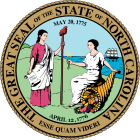North Carolina Council of State facts for kids

|
|
| Council overview | |
|---|---|
| Formed | November 12, 1776 |
| Jurisdiction | Government of North Carolina |
| Headquarters | Raleigh, North Carolina |
The North Carolina Council of State is the collective name for the senior executive offices in the Government of North Carolina, all of which are established by the Constitution of North Carolina. Currently, the Council of State includes the popularly elected Governor, Lieutenant Governor, Secretary of State, Auditor, Treasurer, Superintendent of Public Instruction, Attorney General, Commissioner of Agriculture, Commissioner of Labor and Commissioner of Insurance. In its current form, the Council of State meets periodically, with the Governor as chair, to allow for coordination and exchange of information across executive branch agencies and to vote on certain decisions, especially regarding the sale of government property or the borrowing of money.
When the first North Carolina Constitution was written in 1776, the Councilors of State and the Governor were elected by the North Carolina General Assembly. In 1868, the constitution was amended to define the Council of State as the Secretary of State, State Treasurer, State Auditor, and the Superintendent of Public Instruction. Additional elected offices have since been added to the Council of State, as listed in the table below.
The Council of State is separate from the North Carolina Cabinet, which is appointed by the Governor, and makes up the rest of the State's executive leadership. However, members of the Council of State are often colloquially and erroneously called cabinet members.
History
North Carolina retains a unique system of divided executive power. The term "Council of State" harks back to a colonial era provincial council, which was essentially the upper house of the legislature, and then to a Council of State during the American Revolution, which was appointed by the legislature and curtailed the Governor's power. The North Carolina Constitution of 1776 required "that the Senate and House of Commons, jointly, at their first meeting after each annual election, shall by ballot elect seven persons to be a Council of State for one year, who shall advise the Governor in the execution of his office." When a new Constitution was adopted in 1868, the name and some of the powers or duties of the Council were retained, but instead of being appointed by the legislature, the members were now executive officers who were elected statewide, serving ex officio on the Council. At first, only the Secretary of State, State Auditor, State Treasurer, Superintendent of Public Instruction, and Superintendent of Public Works (an office which only existed briefly and was abolished in 1873) were on the Council of State. The revised state Constitution of 1971, which is currently in effect, provides that the Council of State consists of all the officers established by Article III of the document.
Incumbents and first officeholders
| Office | Incumbent | Party | Office established |
First officeholder | |
|---|---|---|---|---|---|
| Governor | Roy Cooper | Democratic | 1776 | Richard Caswell | |
| Lieutenant Governor | Mark Robinson | Republican | 1868 | Tod Robinson Caldwell | |
| Secretary of State | Elaine Marshall | Democratic | 1776 | James Glasgow | |
| Auditor | Beth Wood | Democratic | 1863 | Samuel F. Phillips | |
| Treasurer | Dale Folwell | Republican | 1776 | John Baptista Ashe | |
| Superintendent of Public Instruction | Catherine Truitt | Republican | 1853 | Calvin H. Wiley | |
| Attorney General | Josh Stein | Democratic | 1776 | Waightstill Avery | |
| Commissioner of Agriculture | Steve Troxler | Republican | 1877 | Leonidas L. Polk | |
| Commissioner of Labor | Josh Dobson | Republican | 1887 | Wesley N. Jones | |
| Commissioner of Insurance | Mike Causey | Republican | 1899 | James R. Young | |
The 1776 Constitution prescribed that the General Assembly would select the following officials:
- Governor, serving for one year
- Secretary of State, selected triennially.
- Attorney General, who held the office during good behavior
- Treasurer, serving for one year
- Seven persons to be Councilors of State, serving for one year
The Council of State included only the seven councilors selected by the General Assembly.
The 1835 Constitutional Convention provided an amendment to the Constitution of 1776 that required that the Governor be elected by the voters, and he would serve a two-year term.
In the 1868 Constitution, an executive department was defined as the Governor, Lieutenant Governor, Secretary of State, Auditor, Treasurer, Superintendent of Public Works, Superintendent of Public Instruction, and Attorney General. All were to be elected by the voters of the State for terms of four years at the same time that the General Assembly was elected. The appointed, separate Council of State was abolished and in its place, the ex-officio members of the Council of State would be the Secretary of State, Auditor, Treasurer, Superintendent of Public Works, and Superintendent of Public Instruction. They would advise the Governor in the execution of his office.
First Council of State
The General Assembly of 1777 was responsible for electing Councilors of State. They elected the following councilors on April 18, 1777:
- William Cray from Onslow County
- William Haywood from Edgecombe County
- Joseph Leech from Craven County
- Edward Starkey from Onslow County
- Thomas Eaton from Bute County
- Cornelius Harnett from New Hanover County
- William Taylor from Duplin County

